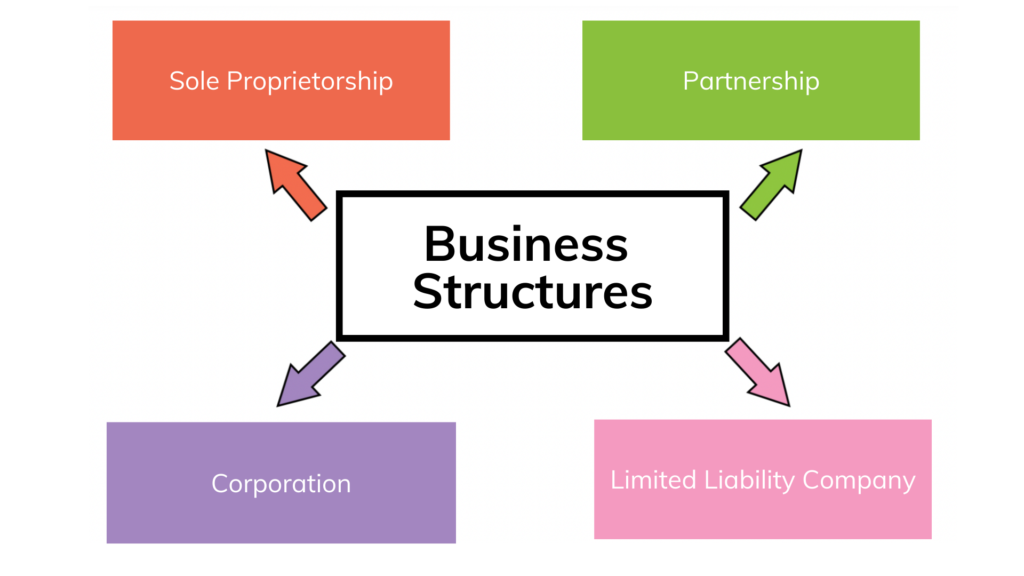Understanding Business Entity Types: Choosing the Right Structure for Your Venture
Choosing between business entity types is a pivotal decision for your business, affecting everything from taxes to personal liability and control. This article delves into the key differences between the primary types—sole proprietorships, partnerships, LLCs, and corporations—and assists you in determining which might be the most suitable for your company.
Key Takeaways
- The choice of business entity significantly impacts legal liability, tax obligations, and management structure, influencing every aspect of a business’s operations and potential for growth.
- Key business entity types include sole proprietorships, partnerships, LLCs, and corporations (S & C), each offering different levels of liability protection, tax treatment, and suitability for various growth and investment goals.
- Business owners must carefully consider and often reevaluate the most fitting business structure for their evolving needs, balancing risk, growth potential, and legal and tax implications in their decision-making process.
Deciphering Business Entity Types

Starting a business requires a clear understanding of the various business structures, each with its distinctive impact on taxes, liability, and management. From the straightforward nature of a sole proprietorship to the complex structure of a corporation, the type of business entity you choose not only reflects your company’s character but also its future path. A separate legal entity defines how your business operates within legal, fiscal, and administrative frameworks. Understanding the different business entities is crucial for your venture’s growth.
The business structure you choose is a foundational decision that affects every part of your operation. It determines how you are viewed legally, how you manage your taxes, and the level of personal risk you are willing to take. As you consider which business structure to choose, whether it be a sole proprietorship, partnership, LLC, or corporation, keep in mind that this choice will shape your business’s journey from its inception to its future success. Carefully evaluate the pros and cons of each option to ensure that your business structure aligns with your goals and growth plans.
Sole Proprietorship Explained
A sole proprietorship is the simplest and most common form of business entity, where you, the sole owner, have complete control over all business decisions. This structure is ideal for those who seek the freedom to operate their venture with minimal formalities. The appeal of a sole proprietorship lies in its ease of formation and affordability, making it an attractive choice for many first-time entrepreneurs who value simplicity.
However, this simplicity comes with significant responsibility. As a sole proprietor, there is no legal distinction between your business and personal assets concerning liability. You are personally responsible for all debts and obligations your business incurs, which means your personal assets are at risk. Additionally, a sole proprietorship is not a registered entity with the state, and the owner is considered self-employed, meaning you will need to handle self-employment taxes. While this entity may be the most accessible option for launching your business idea, it is essential to consider the potential risks involved and whether this structure aligns with your long-term goals.
Partnership Fundamentals
Starting a business with a trusted partner or partners can lead to the formation of a general partnership, where management and profits are shared equally. In partnerships, general partnerships are common, with each partner investing not just capital but also effort into the business’s daily operations, sharing both the rewards and the risks.
The heart of a partnership is found in shared efforts and shared risks. Partners must work together, with every financial decision affecting the group as a whole. It is a type of business that relies on mutual understanding, often supported by a partnership agreement that outlines roles, responsibilities, and how to handle disputes.
Additionally, it is crucial to think about the legal implications and potential conflicts that may arise. A well-written partnership agreement can help prevent issues by detailing the process for adding or removing partners, handling profit distribution, and dealing with unexpected events like the death or incapacitation of a partner. This ensures that the partnership remains stable and continues to operate smoothly, even in challenging situations.
Limited Liability Company (LLC) Spotlight
A Limited Liability Company (LLC) offers its owners the protection of limited liability, shielding personal assets from business debts and lawsuits. This protective feature does not come at the cost of flexibility, as LLCs provide a tax structure that allows owners to choose the most advantageous tax treatment.
Establishing an LLC requires more steps than forming a sole proprietorship but remains less complex than creating a corporation. With the simplicity of a sole proprietorship and the legal protections of a corporation, LLCs are favored by a diverse range of business owners, from freelancers to growing enterprises seeking a balance of simplicity and security.
Another important detail about LLCs is the operational flexibility they offer. Owners, referred to as members, can decide how the company is managed, either by themselves (member-managed) or by appointing managers (manager-managed). This flexibility allows for a customizable approach to running the business, catering to the specific needs and preferences of the owners.
The Ins and Outs of S Corporations
An S corporation benefits from pass-through taxation, where profits and losses flow directly to the owners’ personal tax returns, avoiding corporate-level taxation. At the same time, an S corporation provides limited liability protection, ensuring that the personal assets of the shareholders are protected from the business’s liabilities.
While S corporations benefit from pass-through taxation, they face restrictions such as a 100-shareholder limit and the requirement to have only one class of stock. Shareholders must be individuals, certain trusts, or estates, excluding partnerships, corporations, and non-resident aliens. These limitations can impact expansion and investment opportunities.
Despite these restrictions, S corporations are particularly attractive to small and family-owned businesses due to their tax advantages and liability protections. They offer a balanced approach for those seeking to combine the benefits of a corporation with the tax simplicity of pass-through taxation. Careful planning and adherence to IRS guidelines are essential to maintaining S corporation status and reaping its benefits.
The Structure of C Corporations
C corporations operate as separate legal entities from their owners, governed by shareholders, a board of directors, and officers. This structure is ideal for businesses aiming for significant growth, with the ability to raise capital through the issuance of stock. By selling shares, C corporations can attract a wide range of investors, from private individuals to large institutional investors, providing the financial resources necessary for expansion and innovation.
While C corporations provide robust protection for owners’ personal assets, they are subject to complex regulations and tax laws, including the potential for double taxation. Double taxation occurs because the corporation’s profits are taxed at the corporate level, and any dividends distributed to shareholders are taxed again on their personal tax returns. Despite these challenges, the structure offers unparalleled opportunities for raising capital and expanding the business. Additionally, C corporations can issue multiple classes of stock, offering flexibility in attracting and retaining investors with different risk appetites and investment goals.
C corporations also benefit from perpetual existence, meaning the business can continue to operate independently of the original owners’ involvement, which is advantageous for long-term planning and stability. This continuity can be particularly appealing to investors looking for reliable, long-term investment opportunities. Furthermore, C corporations can deduct certain business expenses, such as employee benefits, which can reduce the overall taxable income and provide additional financial advantages.
Overall, the C corporation structure is well-suited for companies with ambitions of significant growth, a need for substantial capital, and a desire for strong legal protections for its owners.
Selecting the Optimal Business Structure

The quest for the ideal business structure is a strategic process, marked by careful consideration and foresight. Your choice of business entity will significantly impact your venture’s growth, financial commitments, and leadership style. The business structure you select will influence your organizational framework, fundraising capabilities, and exposure to liabilities.
This decision should not be made in isolation. It’s essential to seek advice from a professional, such as an accountant. Their expertise can help you navigate the complexities of different business entities, ensuring that your choice aligns with your current needs and future goals.
Considerations for Legal Protections
When selecting the structure under which your business will operate, the legal protections it offers should be a primary consideration. The level of personal liability you’re willing to accept varies with each business entity type, from the full exposure of sole proprietorships and general partnerships to the fortified protections of LLCs and corporations.
Sole proprietors and general partners face unlimited personal liability, where personal assets are at risk to cover business debts. Limited partnerships offer a compromise, with one general partner bearing the brunt of liability while limited partners enjoy a measure of safety. As a small business grows, transitioning into an LLC may provide a more secure platform, shielding personal assets while still allowing for the close control many entrepreneurs value.
Tax Implications for Each Entity Type
Each type of business entity navigates the complex landscape of taxation differently. Entities like sole proprietorships, partnerships, and S corporations allow profits to flow directly to the owners’ personal tax returns, avoiding entity-level taxes. However, the way these entities are taxed can differ significantly.
For sole proprietorships, the owners report business income and expenses directly on their personal tax returns and are subject to self-employment taxes on their share of the income. Partnerships file an informational tax return and issue K-1 forms to each partner, detailing their share of the profits and losses, which the partners then report on their personal tax returns. The burden of self-employment taxes falls upon the general partners.
In contrast, S corporations also offer pass-through taxation but are not subject to self-employment taxes. Instead, owners can take a salary (subject to payroll taxes) and receive distributions (not subject to self-employment taxes), potentially reducing their overall tax burden.
For those seeking to avoid double taxation, the LLC offers a flexible tax structure that can be tailored to the most advantageous scenario for the business. In contrast, the C corporation is subject to corporate taxes, distinct from the personal taxes of its owners, which can lead to double taxation when profits are distributed as dividends.
Growth and Funding Prospects
The business entity you choose significantly impacts your ability to raise capital and manage growth. Corporations, with their capacity to issue stock, are particularly effective at raising funds, providing a strong foundation for expansion.
In contrast, sole proprietorships may encounter difficulties in securing financing due to the blend of personal taxes and liability. As your business develops, transitioning to an LLC or corporation can offer the necessary structural support for rapid growth while protecting you from personal risks associated with expansion.
Overview of a Limited Liability Partnership

A Limited Liability Partnership (LLP) is a distinctive hybrid, merging the teamwork aspect of a partnership with the protective features of limited liability. This combination creates a business entity where partners are insulated from the debts and actions of the partnership, allowing them to focus on their individual contributions while being anchored in a shared enterprise.
The structure of an LLP offers robust protection for each partner’s personal assets against the liabilities and legal challenges faced by the business. It is a favored choice among professionals who wish to collaborate without the risk of being held accountable for the actions of their peers.
Defining Roles in a Limited Liability Partnership
In an LLP, each partner’s role and liability are clearly delineated, with specific responsibilities while enjoying protection from liabilities arising from their fellow partners’ actions. The partnership agreement serves as the foundational document that outlines each partner’s duties and obligations, ensuring coordinated and efficient operations.
The distinction between general and limited partners in an LLP is crucial. General partners take on full liability and are actively involved in managing the business, while limited partners contribute financially without engaging in day-to-day operations, thus limiting their liability.
Transitioning to a Limited Liability Partnership
Transitioning from a sole proprietorship to an LLP is a significant step, requiring meticulous planning and formal documentation. This transition involves adding partners to the business, formalizing the structure through a comprehensive partnership agreement, and filing the necessary paperwork with the Secretary of State.
This change provides the business with enhanced protection from personal liability for the business’s debts and actions, offering a more secure foundation for growth and collaboration. The LLP structure thus serves as a safeguard, allowing the business to navigate challenges while pursuing its objectives.
Mastering the Lifecycle of Your Business Entity

The life of a business entity can be unpredictable, requiring quick thinking and good planning to stay on track. Restructuring, whether due to mergers, acquisitions, or a new strategic direction, marks a new chapter in a company’s journey. Successful reorganization relies on solid planning and clear communication to guide the company through changes.
Starting Small and Scaling Up
The journey of a business often starts with a simple structure tailored to its initial needs, providing flexibility and control. As businesses grow and evolve, their structural requirements may change, necessitating a transition to a more suitable framework. This shift ensures the business can continue to expand and manage risks effectively.
For instance, an LLC might offer a balance of simplicity and legal protection, while a corporation could provide robust legal protections and opportunities for raising capital. Adapting the business structure to align with its growth and changing needs is crucial for long-term success.
When and How to Restructure
Recognizing the signs that indicate a need for restructuring can be as subtle as observing shifts in performance or operational inefficiencies. These signals might manifest as performance gaps, operational inefficiencies, or new opportunities that require a different organizational structure.
Examples of When Restructuring Takes Place:
- Upgrading from Sole Proprietorship to LLC: A freelance graphic designer, initially operating as a sole proprietorship, decides to form an LLC to protect personal assets as their client base and revenue grow.
- Transitioning from Partnership to Corporation: A small law firm initially structured as a general partnership decides to become a corporation to attract investors and offer stock options to employees.
- Converting to an S Corporation for Tax Benefits: A family-owned restaurant operating as an LLC restructures into an S Corporation to take advantage of pass-through taxation and avoid double taxation on earnings.
- Switching from C Corporation to LLC: A tech startup initially formed as a C Corporation decides to convert to an LLC to simplify management and reduce the burden of double taxation as it scales down operations.
- Forming a Limited Liability Partnership (LLP): A group of doctors practicing as a general partnership restructures into an LLP to limit personal liability while maintaining the collaborative nature of their practice.
The decision to restructure, whether it’s transitioning to a limited liability partnership or another form, is not without its complexities. It can involve tax implications or even the risk of dissolving the business if not managed carefully. Dissolving a business can be risky because it may lead to the loss of valuable assets, customer relationships, and brand reputation. Additionally, there could be legal and financial repercussions, such as outstanding debts and obligations that need to be settled. Therefore, thorough planning and consideration are essential to mitigate these risks and ensure a smooth transition.
A business owner must weigh these considerations with a thorough understanding of the potential consequences and prepare a detailed plan for the transition. This process ensures that the business determines the best course of action to achieve long-term success.
Liability and Asset Management

Your chosen business structure is more than just a setup; it acts as a shield against the unpredictable challenges of the business world. It plays a vital role in protecting your personal assets from potential liabilities. While sole proprietorships and partnerships expose you to personal liability, structures like C corporations create strong barriers between the business’s debts and your personal wealth, giving you peace of mind as you navigate entrepreneurship. Additionally, safeguarding your business assets is key to ensuring long-term success and stability.
Staying compliant with various tax obligations, regulations, and necessary paperwork becomes part of your daily operations, dictated by the business structure you choose. It’s an ongoing process requiring vigilance and foresight to keep your business on track and your assets protected from unexpected challenges.
Balancing Risk with Business Activities
Navigating the business landscape is all about managing risk, requiring a strategic approach to identify potential hazards and mitigate them. It involves:
- Understanding Risks: Recognize the various risks your business might face, including financial, operational, legal, and market risks.
- Assessing Impact: Evaluate the potential impact of these risks on your business operations, finances, and reputation.
- Implementing Defenses: Put in place measures to protect your business from identified risks. This could involve insurance, robust contracts, and compliance with regulations.
- Adjusting Business Structure: Sometimes, changing the business structure is necessary to better match the level of risk you’re willing to take on. This could mean:
- Incorporating: Forming a corporation to provide strong legal protections for personal assets.
- Forming an LLC: Creating a Limited Liability Company to balance flexibility and liability protection.
These decisions are crucial for setting up the right safeguards for the future and ensuring your business can withstand potential challenges.
Estate Planning and Business Continuity
For the dedicated business owner, ensuring that their venture can survive their absence is a critical part of planning. Estate planning acts as a guide through the uncertainties that may follow the loss of leadership. Business continuity plans are essential for charting a course for the company’s future, ensuring that operations remain stable and leadership transitions smoothly.
Implementing strategies like Employee Stock Ownership Plans (ESOPs) can be key to retaining important staff during times of transition, protecting the company’s operations and future prospects. An ESOP is a program that provides employees with ownership interest in the company, aligning their interests with the success of the business. Other examples of retention strategies include offering career development opportunities, flexible working arrangements, and performance-based bonuses. These measures ensure that your business not only survives but continues to thrive, even in the face of significant challenges.
Summary
Selecting the appropriate business structure is a pivotal decision that will shape the future trajectory of your venture. Whether you opt for the simplicity of a sole proprietorship or the intricate framework of a corporation, each type of entity presents unique benefits and challenges. Through meticulous planning, a thorough understanding of legal and tax ramifications, and a focus on growth potential, you can pave the way for your business’s success.
Navigating the complexities of business formation and compliance can be challenging. As experienced business tax accountants, we provide expert guidance and support throughout the process. Our services include business formation, compliance, and restructuring, ensuring that your enterprise is built on a solid foundation and remains compliant with all regulatory requirements. Partner with us to secure the professional expertise necessary for your business’s growth and long-term success. Contact us today to learn how we can assist you in achieving your business objectives.

Client Support
Have questions about your current services or need assistance? Contact our dedicated support team for personalized assistance tailored to your needs.

Discover Our Services
Interested in learning more about our services and how we can help your business? Schedule a consultation with one of our experts to explore your options.



